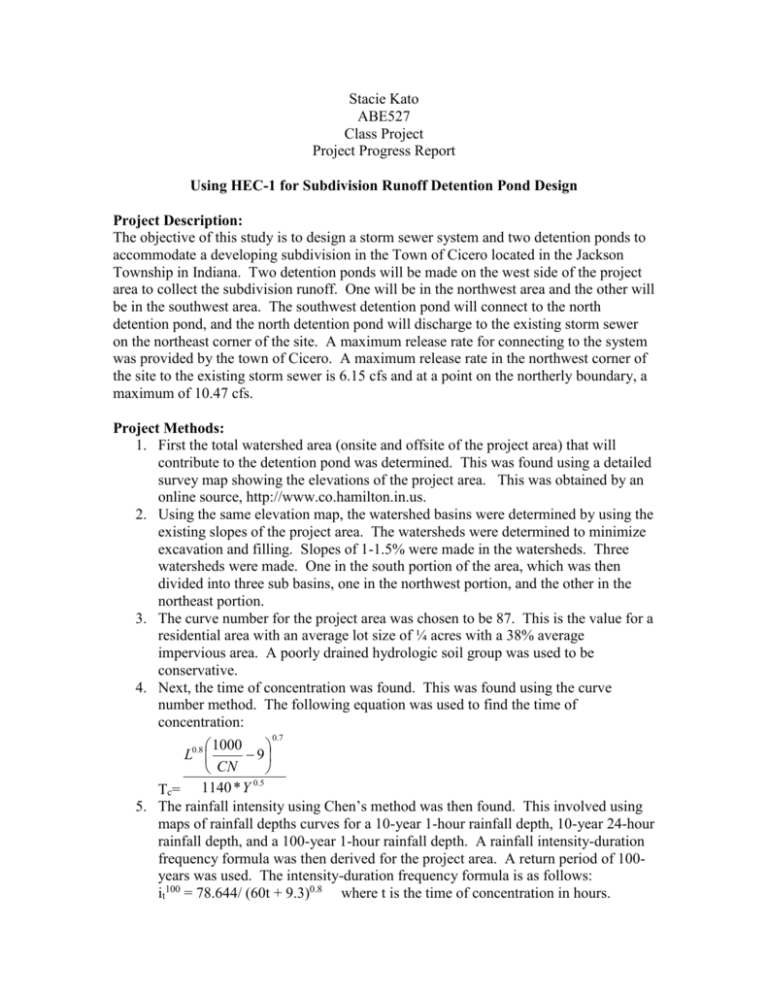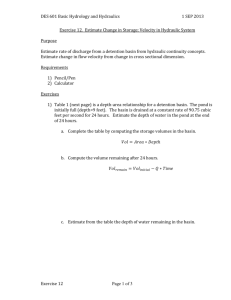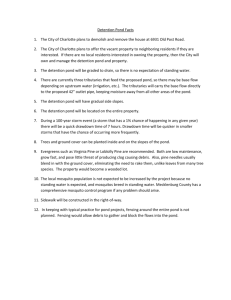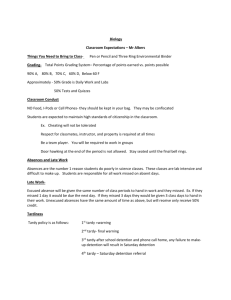katosprogress
advertisement

Stacie Kato ABE527 Class Project Project Progress Report Using HEC-1 for Subdivision Runoff Detention Pond Design Project Description: The objective of this study is to design a storm sewer system and two detention ponds to accommodate a developing subdivision in the Town of Cicero located in the Jackson Township in Indiana. Two detention ponds will be made on the west side of the project area to collect the subdivision runoff. One will be in the northwest area and the other will be in the southwest area. The southwest detention pond will connect to the north detention pond, and the north detention pond will discharge to the existing storm sewer on the northeast corner of the site. A maximum release rate for connecting to the system was provided by the town of Cicero. A maximum release rate in the northwest corner of the site to the existing storm sewer is 6.15 cfs and at a point on the northerly boundary, a maximum of 10.47 cfs. Project Methods: 1. First the total watershed area (onsite and offsite of the project area) that will contribute to the detention pond was determined. This was found using a detailed survey map showing the elevations of the project area. This was obtained by an online source, http://www.co.hamilton.in.us. 2. Using the same elevation map, the watershed basins were determined by using the existing slopes of the project area. The watersheds were determined to minimize excavation and filling. Slopes of 1-1.5% were made in the watersheds. Three watersheds were made. One in the south portion of the area, which was then divided into three sub basins, one in the northwest portion, and the other in the northeast portion. 3. The curve number for the project area was chosen to be 87. This is the value for a residential area with an average lot size of ¼ acres with a 38% average impervious area. A poorly drained hydrologic soil group was used to be conservative. 4. Next, the time of concentration was found. This was found using the curve number method. The following equation was used to find the time of concentration: 0.7 1000 L 9 CN 0.5 1140 * Y Tc= 5. The rainfall intensity using Chen’s method was then found. This involved using maps of rainfall depths curves for a 10-year 1-hour rainfall depth, 10-year 24-hour rainfall depth, and a 100-year 1-hour rainfall depth. A rainfall intensity-duration frequency formula was then derived for the project area. A return period of 100years was used. The intensity-duration frequency formula is as follows: it100 = 78.644/ (60t + 9.3)0.8 where t is the time of concentration in hours. 0.8 6. The peak flow was then calculated using the rational method. A runoff coefficient of 0.8 was used based on an urban residential area with 70% impervious area for a poorly drained hydrologic soil group to be conservative. Using the formula: Q = CiA, the peak flow was calculated for each basin. The peak flow for the south basin was found for all three sub basins. The peak flow for sub basin two is at the inlet point, which accounts for the flow from sub basin one. The peak flow for sub basin three is at the inlet point, which accounts for the flow from all three sub basins. 7. With the peak flows, the volume of runoff was calculated using the triangular hydrograph. The volume was found using, V = (tpqp/2) + (trqp/2), where qp is the peak flow in ft3/hr and tp and tr are time in hours. tp = i/2 + 0.6tc where i is the intensity and tc is the time of concentration. tr = 1.67tp. South Basin Subbasin 1 Subbasin 2 Subbasin 3 North West Basin Area (acres) 7.633 7.346 5.725 tc (min) 20 18 16 i (in/hr) 5.27 5.58 5.93 peak flow (cfs) 32.18 66.866 98.207 tp (hr) 2.835 2.97 3.125 tr (hr) 4.73445 4.9599 5.21875 Volume (ft3) 438452.822 954433.248 1474946.38 5.05 20 5.27 21.29 2.835 4.73445 290076.463 11.8945 20 5.27 50.147 2.835 4.73445 683253.376 North East Basin This is as far as my progress for this project goes. The next step involves using HEC-1. Future steps: 8. The volume of runoff for the watershed that was calculated using the triangular hydrograph will be confirmed by using HEC-1, which determines runoff of watersheds by using the rainfall data, time of concentration, land use, and curve number. A hydrograph will be made for the watershed without a detention pond. 9. A detention pond will then be included and a hydrograph with the detention pond will be made. By changing the detention pond parameters, the desired peak out flow from the detention pond can be obtained. The detention pond will be designed based on meeting the maximum release rate requirements set by the town of Cicero. The maximum release rate in the northwest corner of the site to the existing storm sewer is 6.15 cfs. This means that the northwest detention pond will be designed to meet this requirement. The southwest detention pond will be designed to obtain the most practical outflow to the northwest detention pond. It will be connected to the northwest detention pond by a pipe. 10. Storm sewers will be designed to direct the runoff to the detention ponds. The sizes will be based on the runoff flow calculated.






